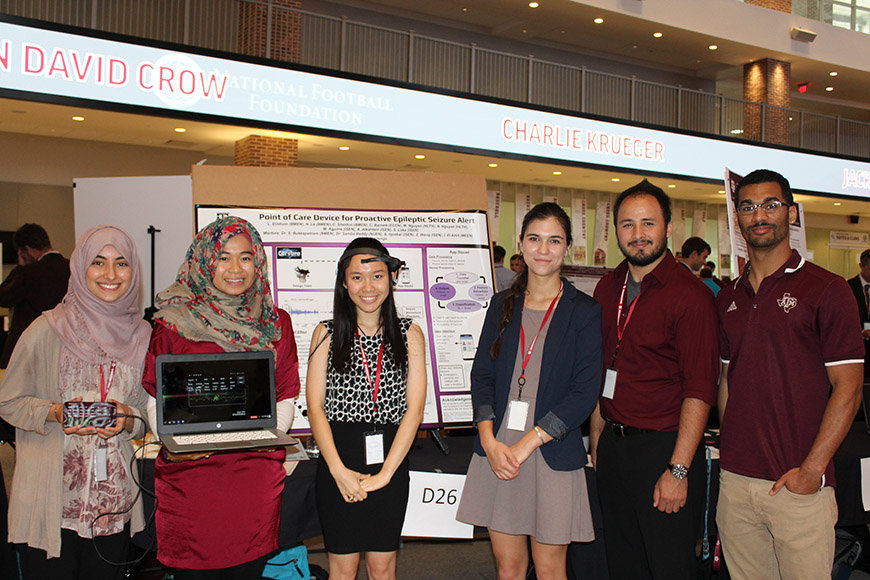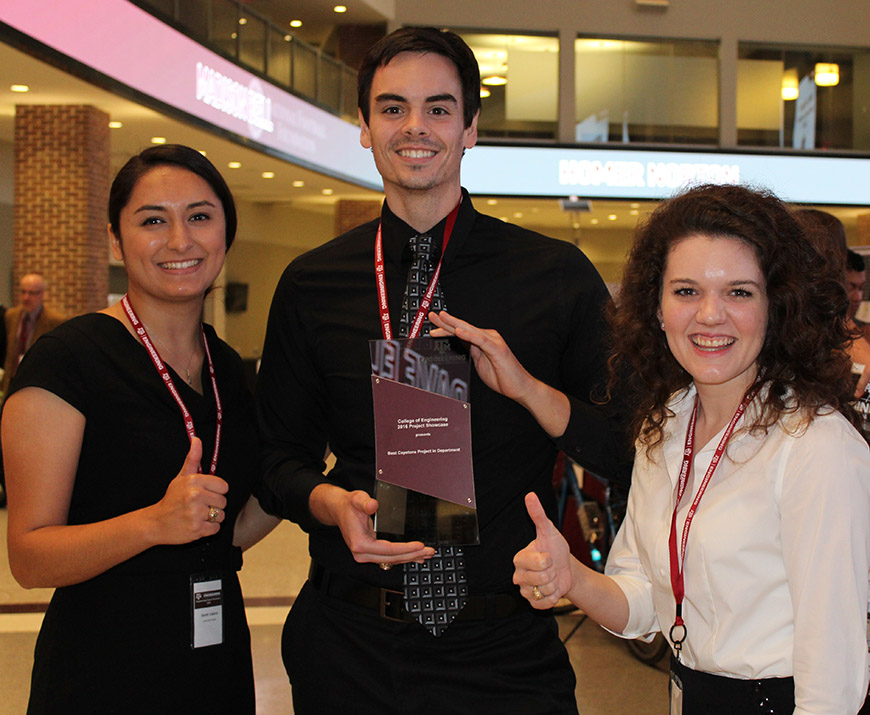The Department of Industrial and Systems Engineering at Texas A&M University was well-represented at the annual College of Engineering Project Showcase. Four teams and 30 students participated in the event, explaining their research and solutions to industry leaders.
The 2016 Engineering project showcase featured the work of 145 teams comprised of more than 750 students. Two teams with students from the Department of Industrial and Systems Engineering received top awards at the showcase.
“Our students are constantly learning and researching ways to better our world,” said Dr. César Malavé, head of the department. “The Engineering Project Showcase is a great opportunity for them to present their research as well as learn from other teams in other disciplines.”
Notifying Caretakers
Families with loved ones taking prescription medication have a hard time reassuring themselves that their medication is being taken consistently and correctly. A team of students is developing technologies that remind users to consume their medication as prescribed by their doctor, then send notifications to their loved ones.
“By doing this, we are attempting to solve prescription compliance problems that are currently a burden to national healthcare systems and kill an estimated 125,000 individuals annually in the U.S.,” said Dylan Begnaud, a junior industrial and systems engineering major.
Begnaud works with Sanjay Nair, a graduate student in the Department of Electrical and Computer Engineering, and Jason Sieben, a senior computer science major.
“We establish a healthy form of communication again between family members instead of treating our elders like children,” Begnaud said. “Every day we get notifications from Facebook, why not have notifications when your loved ones have taken their medication?”
Measuring Performance

EDP Renewables (EDPR) primarily uses wind turbines to generate electricity with renewable energy. As an energy wholesaler, EDPR recently made a strategic shift to perform maintenance on its wind turbines rather than contracting out maintenance work with the equipment manufacturer. While the company takes on more risk by handling its own maintenance work, it can be certain the work is done correctly and efficiently.
“The objective of our project was to update EDPR’s set of key performance indicators (KPIs) to accurately measure and describe their wind farm’s performance in detail,” said Mitchell Mesenbrink, a senior industrial and systems engineering major. “The metrics must align EDPR’s new self-perform maintenance model and focus on driving value by achieving maximum equipment reliability and performance while minimizing cost.”
The team is comprised of senior industrial and systems engineering students, Jake Klahs, Joel Betancourt, Kevin Hsieh and Mesenbrink. With the potential to grow the renewable energy industry, Mesenbrink and his team is excited to present its report to the representatives at EDPR.
“Helping make renewable energy sources more viable on a large scale is better for our planet and future generations of people,” Mesenbrink said. “The most beneficial part of this experience was working with the EDPR representatives to create something that is meaningful and useful.”
Predicting Seizures
The National Institute of Neurological Disorders and Strokes states that two million people in the United States have experienced an unprovoked seizure or been diagnosed with epilepsy. During the past 30 years, several algorithms for predicting seizure onset based on EEG recordings have been developed, but with limited success.
“Our system aims to detect, predict and notify the patient before the seizure occurs and text the location of the patient to their loved ones upon predicting a seizure,” said Sheril Loke, a senior industrial and systems engineering major. “Additionally, the caretakers can consistently and reliably monitor the patient’s epilepsy condition on a daily basis.”

The placement of the sensor to perform an EEG requires an invasive technique, as of today. The team will develop and design a lessinvasive and comfortable device to perform the same tests.
“The outcome of the project would provide a non-invasive and comfortable wearable headset device coupled with an effective detection and prediction algorithm with over 90 percent accuracy,” said Ashif Iquebal, a graduate student in the Department of Industrial and Systems Engineering. “This device will be integrated with a mobile application that can allow point of care and real-time monitoring of the seizure.”
The multi-disciplinary team has students working in four main groups to ensure the timely achievement of the project goals.
“As students, the most beneficial part of this project was getting the chance to work on an interdisciplinary project, among many different nationalities and of all different levels of education,” Loke said.
The team was one of two teams to be selected as winners of the Shell Award at the Engineering Showcase last month. This award is presented to the highest scoring non-capstone team project by the College of Engineering at Texas A&M.
Creating Interest
With a declining interest in areas of science, technology, engineering and math (STEM) in elementary school children, the STEM Space team has developed a game to reverse the trend.
“The way we get kids hooked on learning is by making the app social,” said Julian Franklin, a junior industrial and systems engineering major. “Our research showed that a gaming aspect helped promote kids to compete and collaborate with each other in order to have the highest score.”
The younger students were not the only ones learning from this project. The engineering students also learned to work off of each other’s strengths and weaknesses.
“The most beneficial part of this experience has been learning how to play to the strengths and weaknesses of an individual in a team,” Franklin said.
The team was comprised of Franklin, Nivedhan Manavalan, a graduate student in the Department of Information and Operations Management; Mohammad Sagor, a sophomore computer science major; Thomas Rockwood, a sophomore biological and agricultural engineering major; Murphy Young, a graduate student in the Department of Teaching, Learning, and Culture; and Austin Verrett, a junior industrial and systems engineering major.
Optimizing a New UPS Hub
As a part of the senior capstone design course, a team of four industrial and systems engineering students were tasked with planning a United Parcel Service (UPS) facility that will be built in 2018 in Houston. When planning the facility, UPS asked the team to balance the workload per center, determine the number of drivers and vehicles needed on the first day of operation and suggest an implementation process as the area continues to grow.

“Our project will help UPS better service hundreds of thousands of customers in the Houston area,” said Robin Hall, a senior industrial and systems engineering major. “We also strove for a solution that would create an ideal work situation for hundreds of UPS employees.”
The team was excited to have the opportunity to apply their undergraduate education to a real-world situation.
“The most beneficial part of this experience was getting the chance to work collaboratively with a company we respect,” Hall said. “Most of our education has been theoretical and it has been a great experience to apply our knowledge to a real-world problem.”
Hall and her team members, Charles Bentz, Cody Keller, and Sarah Valero, worked all semester to design a plan for UPS and help its customers in the Houston area.
“Our planning will now help UPS get their packages to the public’s door as efficiently as possible,” Hall said. “Hopefully it will allow UPS to maintain low prices and excellent customer relations.”
The team competed against other capstone design teams in the Engineering Showcase last month. Its project was selected as the winner of the Capstone – Other Majors category.
Bringing Home the Gold
“The Engineering Showcase gives our students an opportunity to showcase their work, practice critical skills and get recognized for what they have done – it’s the trifecta of opportunities,” said José Vazquez, lecturer in the Department of Industrial and Systems Engineering. “In our case, one of our teams has won in each of the past two years, so now we have a tradition to build on that motivates students.”